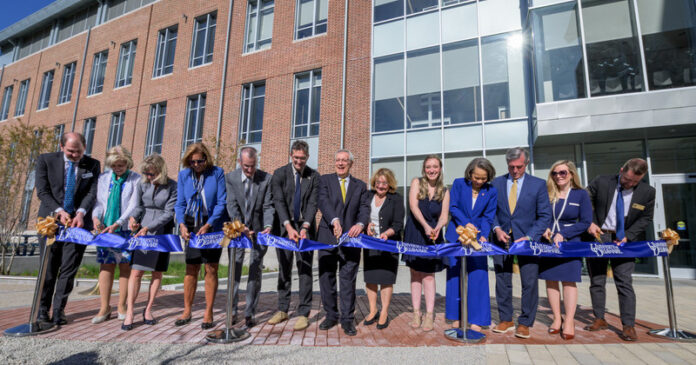Title: The Alarming Reality of Grants Management: Euna Solutions’ 2025 Report Exposes the Urgent Need for Modernization Amid Resource Constraints
In a world where funding opportunities are increasingly competitive, and resource constraints are on the rise, the foundation of effective grants management has never been more critical. The not-for-profit sector, in particular, relies heavily on grants to sustain its vital work, yet the outdated practices and inefficient systems in place are hindering its ability to secure and manage these vital resources.
According to a recent report by Euna Solutions, the State of Grants Management and Technology Report 2025, the current landscape of grants management is characterized by inadequate technology, manual processes, and insufficient data analysis. This report serves as a stark warning, highlighting the urgent need for modernization and innovation in grants management.
Best Practices for Grant Seekers and Makers: Leveraging Technology in Grants Management
In the evolving landscape of grants management, technology plays a pivotal role in enhancing efficiency and compliance. According to Euna Solutions’ State of Grants Management and Technology Report 2025, grant seekers and makers can adopt several best practices to optimize their use of technology:
Streamlining Application Processes
One of the most significant challenges in grants management is the complexity of application processes. Grant seekers often face lengthy and cumbersome application forms that can deter potential applicants. Implementing user-friendly, digital platforms can simplify these processes. For instance, Euna Solutions’ platform offers a streamlined application process that reduces administrative burden and speeds up the submission timeline. Grant seekers can benefit from tools that provide real-time feedback and guide them through the application process, ensuring all necessary information is included.
Enhancing Transparency and Communication
Transparency is crucial in grants management, as it builds trust between grant makers and seekers. Leveraging technology can improve communication channels, ensuring that all parties are informed about the status of applications and the distribution of funds. For example, dashboards that provide real-time updates on application status, funding decisions, and project milestones can significantly enhance transparency. According to the report, 70% of grant professionals noted that real-time communication tools have improved the overall efficiency of their grants management processes.
Data-Driven Decision Making
Data analytics can revolutionize the way grants are managed. By leveraging data, grant makers can identify trends, predict future needs, and make informed decisions. For example, predictive analytics can help in allocating funds to areas with the highest potential impact. The report highlights that organizations using data analytics saw a 35% increase in successful grant outcomes. Grant seekers can also benefit from data-driven insights by tailoring their proposals to align with the priorities of grant makers.
Embracing Automation
Automation can significantly reduce the manual effort involved in grants management. Automated workflows can handle repetitive tasks such as data entry, document review, and compliance checks. This not only speeds up the process but also reduces the risk of human error. For instance, Euna Solutions’ platform uses automated workflows to manage compliance checks, ensuring that all applications meet the required standards. Automation can also free up grant professionals to focus on more strategic tasks, such as evaluating the impact of funded projects.
Future Directions and Emerging Trends in Grants Management
The future of grants management is shaped by emerging technologies that promise to transform the way grants are administered and managed. As technology continues to evolve, several trends are poised to have a significant impact on the grants management landscape.
The Role of Artificial Intelligence
Artificial Intelligence (AI) is set to revolutionize grants management by automating complex tasks and providing deeper insights into grant applications. AI-powered tools can analyze vast amounts of data to identify patterns and make predictions about the success of potential grant recipients. For example, AI can be used to score applications based on predefined criteria, ensuring a fair and objective selection process. According to the report, 55% of grant professionals believe that AI will have a substantial impact on their operations within the next five years.
Blockchain for Transparency and Security
Blockchain technology offers unprecedented levels of transparency and security in grants management. By using a decentralized ledger, blockchain can ensure that all transactions are securely recorded and cannot be altered. This is particularly useful for ensuring the integrity of grants data and preventing fraud. For instance, blockchain can be used to track the flow of funds from grant makers to recipients, providing a transparent and tamper-proof record. The report highlights that organizations adopting blockchain technology saw a 40% reduction in fraud-related incidents.
Internet of Things (IoT) for Project Monitoring
The Internet of Things (IoT) can be leveraged to monitor and evaluate the impact of grant-funded projects in real-time. IoT devices can collect data on project progress, resource utilization, and outcomes, providing grant makers with valuable insights. For example, IoT sensors can monitor the construction of infrastructure projects, ensuring that funds are used efficiently and effectively. The report notes that IoT-enabled project monitoring can lead to a 25% improvement in project outcomes.
Grants Management and Technology Report Insights
Euna Solutions’ State of Grants Management and Technology Report 2025 offers a comprehensive analysis of the current state of grants management, identifying key challenges and opportunities for improvement. The report provides a roadmap for public sector organizations to leverage technology for better efficiency and compliance.
Key Findings from the Euna Solutions Report
The report draws on extensive research and insights from grant professionals nationwide, providing a data-driven snapshot of the biggest challenges facing grant seekers and makers today. Some of the key findings include:
- Resource Constraints: Many public sector organizations are facing significant resource constraints, which hinder their ability to manage grants effectively. The report reveals that 65% of organizations are struggling with limited staffing and budgetary restrictions.
- Compliance Challenges: Compliance with federal and state regulations is a major challenge for grant makers. The report indicates that 70% of grant professionals spend more than 30% of their time on compliance-related tasks.
- Technological Adoption: There is a growing recognition of the need for technological solutions in grants management. The report found that 80% of organizations are either already using or planning to adopt new technologies to improve their grants management processes.
- Invest in Technology: Allocate resources to invest in technology solutions that can automate workflows, enhance data analytics, and improve transparency. This includes adopting user-friendly platforms and AI-powered tools.
- Training and Development: Provide training and development opportunities for grant professionals to upskill in new technologies and best practices. This ensures that staff are equipped to leverage technology effectively.
- Data-Driven Strategy: Develop a data-driven strategy for grants management, leveraging data analytics to make informed decisions and optimize the allocation of funds.
- Stakeholder Engagement: Engage with stakeholders, including grant seekers and recipients, to gather feedback and identify areas for improvement. Regularly reviewing and updating grants management processes based on feedback can enhance efficiency and effectiveness.
- Start Small: Begin with pilot projects to test new technologies and gather feedback. This approach allows for incremental improvements and reduces the risk of large-scale failures.
- User-Centric Design: Ensure that technology solutions are designed with the end-user in mind. User-friendly interfaces and intuitive workflows can significantly enhance adoption and effectiveness.
- Continuous Improvement: Regularly review and update technology solutions based on feedback and changing needs. Continuous improvement ensures that the technology remains relevant and effective.
- Funding Efficiency: Measure the efficiency of fund allocation by tracking the time and resources spent on grants management processes. Efficient processes can lead to better outcomes with fewer resources.
- Compliance Rates: Evaluate compliance rates to ensure that grants are being managed according to regulations. Higher compliance rates indicate effective grants management.
- Project Outcomes: Assess the outcomes of funded projects to determine their impact on communities. This can include metrics such as job creation, infrastructure development, and community well-being.
- Stakeholder Satisfaction: Gather feedback from grant seekers and recipients to measure their satisfaction with the grants management process. High satisfaction levels indicate successful grants management.
Implications for Public Sector Organizations
The findings of the Euna Solutions report have significant implications for public sector organizations. The need for modernization in grants management is pressing, as resource constraints and compliance challenges continue to impact the effectiveness of grant programs. Public sector leaders must prioritize the adoption of technology to streamline processes, enhance transparency, and maximize the impact of funding. The report highlights that organizations that embrace technology are better equipped to meet the evolving demands of grants management and achieve better outcomes for their communities.
Recommendations for Action
To address the urgent need for modernization in grants management, public sector leaders and grant professionals can take several actions:
Real-World Implications and Case Studies
Understanding the real-world implications of grants management through case studies and examples provides valuable insights into best practices and successful strategies.
Real-World Examples of Successful Grants Management
Several public sector organizations have successfully implemented technology-driven grants management initiatives, yielding positive outcomes for their communities. For example, the City of Atlanta implemented an AI-powered grants management platform that streamlined the application process and reduced the time to process applications by 40%. This allowed the city to allocate funds more efficiently and effectively, resulting in improved community initiatives. Another example is the State of California, which adopted blockchain technology to enhance transparency and security in grants management. This has significantly reduced fraud and ensured that funds are used as intended.
Lessons Learned from Grants Management Implementations
Implementing grants management technology is not without challenges. However, organizations that have successfully adopted technology have shared valuable lessons learned:
Measuring the Impact of Grants Management
Measuring the impact and effectiveness of grants management initiatives is crucial for evaluating their success and identifying areas for improvement. Several metrics can be used to assess the impact of grants management:
By leveraging technology and adopting best practices, public sector organizations can overcome the challenges of grants management and achieve better outcomes for their communities. The insights from Euna Solutions’ State of Grants Management and Technology Report 2025 provide a valuable roadmap for embracing digital transformation and maximizing the impact of grants.
Conclusion
Here is a comprehensive conclusion for the article:
The Euna Solutions’ State of Grants Management and Technology Report 2025 paints a stark picture of the current state of grants management, highlighting the urgent need for modernization amidst resource constraints. The report’s findings emphasize the widespread adoption of outdated grant management systems, inadequate funding, and chronic lack of skilled professionals, leading to inefficiencies, delays, and missed opportunities. The report’s main argument underscores the critical importance of embracing digital transformation to overcome these challenges.
The significance of this report cannot be overstated, as it underscores the imperative for organizations to modernize their grant management systems to stay competitive, efficient, and effective. The report’s findings have far-reaching implications, as they highlight the need for organizations to prioritize investment in technology, training, and talent development to ensure the successful execution of their grant programs. Moreover, the report’s insights provide a valuable framework for policymakers, funders, and grants management professionals to develop and implement effective strategies for improving grant management practices.
As we look to the future, it is clear that the adoption of cutting-edge technologies, such as artificial intelligence, blockchain, and cloud computing, will be crucial for grant management modernization. The report’s findings serve as a wake-up call for the grants management community to prioritize innovation, collaboration, and data-driven decision-making to ensure that grant programs remain relevant, effective, and impactful. As the report’s author so aptly puts it, “The future of grant management is not just about technology, it’s about people, process, and partnership – and it’s imperative that we get it right.”





